
Eastern Europe in a Wink, Part IV
Riding high on the heels of our eye opening experience in Serbia, we continued our journey by bus down through the dramatic mountains of Bosnia into Croatia.

COUNTRYSIDE
By the end of the exhaustive 16 hour passage (packed, hot, and no leg room) the sparkling blue Adriatic Sea opened before us, and we spent the last 2 hours captivated by this picturesque Mediterranean landscape. The road hugged tightly to the steep winding hillsides high above the sea and dropped straight into the waters below. Along the way every few kilometers below the road were small idyllic villages of white walls and red roofs that occupied every sheltered harbor. The timeless towns were as much an integrated natural element of the landscape as the thousands of white boulders and knob-bly trees that littered the Dalmation coast.
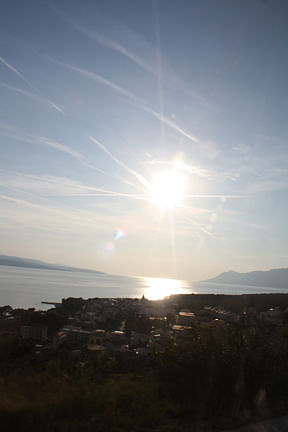
Typical Croatian town tucked into the hillside below. 
The Dalmatian Coast is sheltered by thousands of islands that run parallel up the country 
The Adriatic Sea
Hills of stone and red roof
Old walls and red roofs. There is no train that runs to Dubrovnik, and there is only one real road that dramatically straddles the steep hills
DUBROVNIK
The way was slow, and around every bend we eagerly looked forward in hopes to see the dramatic city we had heard so much about; we were bound for Dubrovnik, the 7th century city of 40,000 people that has one of the best preserved medieval walls in the world. Dubrovnik gained its wealth and prominence from maritime trade, and in its heyday was the only city-state on the eastern side of the Adriatic to rival Venice. Indeed, the city is a romantic fairy tale in every sense, and with this comes the tourism and inflated prices.

Panorama from atop the medieval ramparts
Jennifer Wong, happy in Dubrovnik
Alexander Morley, equally happy in Dubrovnik
It is amazing how well intact the the old city is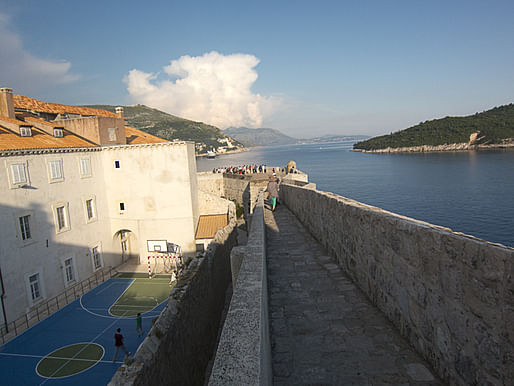
It is possible to literally walk around the entire medieval walls. Down to the left, a Croatian school

Tourism and gimmicks aside, the city was a pure joy to explore. Within the medieval walls of the old town was labyrinth of tight passageways, centered around the logic of a roman inspired grid that has been chipped away with countless idiosyncrasies and timeless interventions. It is a built environment of stone and clay, and on the main thoroughfares the massive pavers have been polished to a smooth and glossy finish; the result of 1500 years and millions of feet.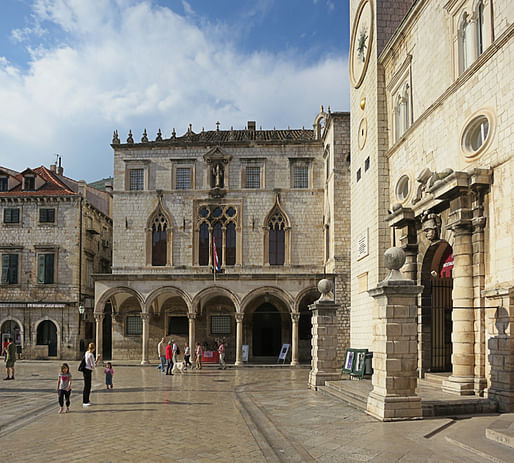 One of the main squares of the old city, Luza Square. Note the smooth pavers
One of the main squares of the old city, Luza Square. Note the smooth pavers
The pavers run seamlessly through interiors and exteriors, as is the case here with the courtyard of the Franciscan monastery. Considered "new" in Dubrovnik, because its not smooth.
Considered "new" in Dubrovnik, because its not smooth. One of the aspects that adds to the pleasure of exploring the city is the widely varied topography on which it is built
One of the aspects that adds to the pleasure of exploring the city is the widely varied topography on which it is built

Peeking into the labrynth, an explorer's delight These curious, yet functional arches lined the main street (Placa Stradun) of the old town
These curious, yet functional arches lined the main street (Placa Stradun) of the old town A wide street for Dubrovnik
A wide street for Dubrovnik
Plazas bustle with street life akin to the Italian Piazza, each with its own church and well. The smell of seafood, cigars, and salt water linger in the air. The sounds of children,neighbors yelling from window to window, pots clanking the kitchens, and church bells punctuate the constant white noise and soft echoes of footsteps and crowd. Around each corner is a government building or palazzo that is loaded with charmingly incorrect mannerist elements of classicism that would make any orthodox Notre Dame student of architecture cringe. The medieval center jetties itself out into the water from which its protective walls rise.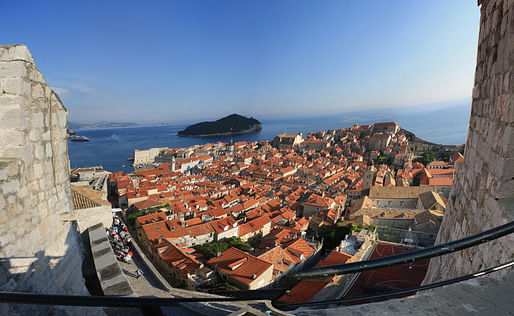
The old city lunges itself out into the sea
Uh oh! Inigo Jones would be pissed! Aside from many other things, this breaks one of the larger rules of the column... a round plinth!! Outside of Rector’s Palace
Rector’s Palace
Rector’s Palace
On its side adjoined to the land, the steep mountainside provides ample shouldered protection. Even in the early 1990’s, Dubrovnik was able to fend off a fierce 7 month siege of the city by Serbian forces as Croatia declared independence from Yugoslavia. The bitterness of the Croatians toward Serbia was quite clear, and it continued the theme of conflict and diplomacy that we encountered in the Balkans.
 This sign is one of the first things you see as you walk through the gates of the medieval quarter... a map that painstakingly shows in detail all the damaged sustained from the siege
This sign is one of the first things you see as you walk through the gates of the medieval quarter... a map that painstakingly shows in detail all the damaged sustained from the siege 
Though the city has done much to rebuild from the damage, there are still many scars, such as this old home with a destroyed roof.
Outside of the medieval walls the city does not lose its charm. The city has dribbled out of the castle gates and has crept up the mountainside. Every bend affords a new view of ocean and fortress from both below and above, each as outstanding as the next. It is a wonderful city.

The adjacent hillside is a labyrinth in itself... a labyrinth of winding, tight, STEEP stairs (none of which would be remotely close to code in the USA) that lead to thousands of lucky residents' homes. Where the ramparts meet both water and land
Where the ramparts meet both water and land
Dubrovnik harbour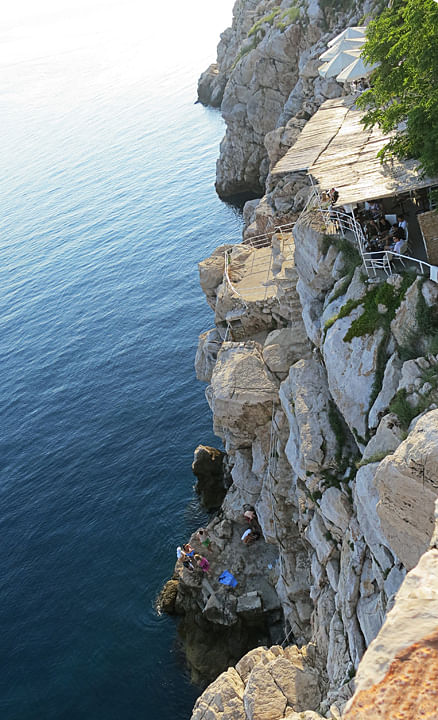
Cliffside bar, complete with cliff jumping teenagers. We chanced upon this beautiful spot
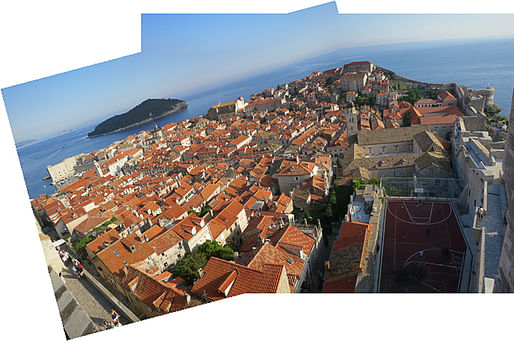
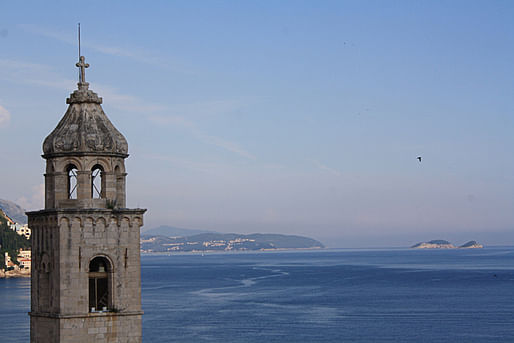

According to CCNGO, the Dubrovnik is ranked as one of the top 10 places in the world for a fairytale proposal. As cheesy as that category is, we cannot argue against it. And we didn't even stay in that hotel they reccommend. Above, sipping wine and watching the evening light in a natural oasis.
SPLIT
Sad to leave, we hopped on another bus to head up north by way of coast to the larger even more ancient city of Split. It is here that the great Roman Emperor Diocletian built his legendary palace. It was here that he died and it was out of this palace that city of Split grew. 
The main harbor of Split.
After the fall of the Eastern Roman Empire, the abandoned palace was occupied by the Byzantine Empire and literally built a city within its interior, retaining the outer walls for defense, and retrofitting the massive interior partitions to become exterior street facades. Today, bits and pieces of the ancient palace are everywhere, and it is not hard to wonder as our hands brush along the columns and walls, “Did Diocletian touch this column? Did Diocletian walk these same steps? On the same stone paver?” It is a unique hodgepodge of the raw classical and the new, to the like of something we have never seen.  The main promenade along the harbor that the locals call the Riva. To the left is what remains of the ancient exterior walls of Diocletian's Palace
The main promenade along the harbor that the locals call the Riva. To the left is what remains of the ancient exterior walls of Diocletian's Palace 
Remnants of the palace are everywhere
 Some of the more prominent nibbles of the ancient building: the Peristile. Once the emperor's square, it was a place reserved only for the Gods. Today, it has a thriving café, frequent live music, and plenty of steps for sitting.
Some of the more prominent nibbles of the ancient building: the Peristile. Once the emperor's square, it was a place reserved only for the Gods. Today, it has a thriving café, frequent live music, and plenty of steps for sitting. Panorama of a public acappela concert we chanced upon in the ruins
Panorama of a public acappela concert we chanced upon in the ruins
The best preserved portion of the original palace is the basement, which was ironically so well preserved because the residents filled it up with their garbage and rubble. It has been slowly excavated over that last 100 years, and continues to be carved out and preserved. It is within these palace walls that the famed Neoclassicist Robert Adam was heavily inspired as he developed a language of grotesque picturesque classicism to counter Inigo Jone’s and Capability Brown’s advocacy of Palladian style.
 Note the perfectly cut stone at the bottom without the use of mortar
Note the perfectly cut stone at the bottom without the use of mortar
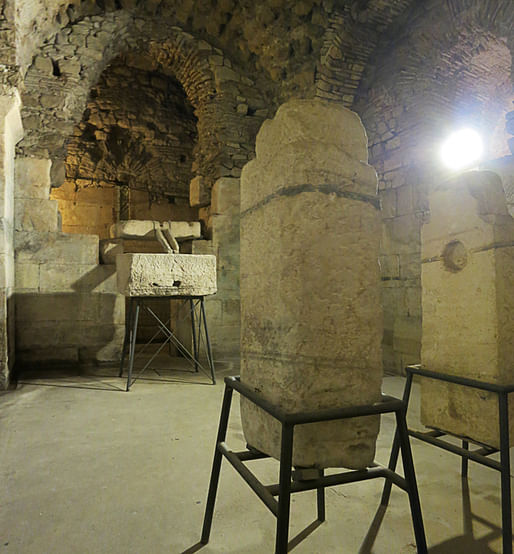
Ancient Olive Press
Like Dubrovnik, the interior of the old city is a time-weathered maze that is physically polished. The absence of cars makes the architecture more human and the scale more intimate.

Reminders of Finnish Brick... then again, it was rather Aalto reminding us in Finland of the Mediterranean.
Outside of the palace, however, it does not retain the same picturesque, but rather reminds one of the fact that it is a larger city of nearly 200,000 residents with sprawling roads, cars, and billboards and chain stores.
It was here we reached the final leg of our Eastern European whirlwind. Having started in the brisk and bright midnight of the Baltics, we had worked our way down to the shorter days and warmer sun of the Mediterranean. We had one more overnight bus followed by a morning in Trieste, Italy to reflect. Upon it. Our only regret is that we did not have more time to see more of these magnificently diverse, friendly, and optimistic cultures that have endured and largely overcome considerable hardship over that last 100 years.
Last stop of the trip: Trieste.

This work by A.D.Morley & J.A.Wong is licensed under a Creative Commons Attribution-NonCommercial-NoDerivs 3.0 Unported License.
A new adventure begins as we finish one chapter; we hope to share our story with you. We are graduates of Washington University in St. Louis, Sam Fox School of Design & Visual Arts.
7 Comments
I enjoyed this post so much! So beautiful.
I was in Split in Spring 1991 - it looks like the waterfront is somewhat cleaned up, but I do remember being amazed that people hung laundry out the windows of Diocletian's home!
I agree with Donna, absolutely love this post and the many, many photos.
As a child, I spent the '92 family summer vacation in Croatia on the tiny island of Rab. Absolutely beautiful, the rich history, the amazing food, the sun, the sea... Wanna go back so bad and visit Dubrovnik and Split this time around. Thanks!
Donna, Alexander:
Thanks! This was one of our favorite posts to put together. As far as the Split Harbour goes, here is all the basic information you can get on the Riva Promenade , which was completed in 2007 by 3LHD Architects based out of Zagreb. This was one of the unmentioned highlights for us in Split; the 180 foot wide promenade is well designed for a diverse amount of simultaneous public activity. If you want sun, there is a place to sit, lay, walk, eat or drink with full southern exposure. At the same time, there is an ample mix of shade for all these activities. It is here that all incoming ships to the palace would moor, and through here that all those who arrive to the city must pass before entering the center. It bustled day and night. We meandered west out of the center along the water, and there is sizable construction and development of the waterfront to this area (as you can see in the photo below). It will be very interesting to see how this new investment of public space sustains itself outside of the city's cultural and physical anchor.
Enjoy, and thanks for reading!
Alex + Jenn
New waterfront construction looking east back to the Riva Promenade and the old walls of Diocletian's Palace
Nice post. I'll be vacationing in Dubrovnik 2 weeks later. The architecture there seems amazing. :)
just so lovely....
I think it is also interesting to note the difference between many of the first posts focusing on examples of northern European Modernism and some of your more recent/later posts which focus much more on various ancient/medieval cities/landscapes/ruins ... from contemporary/sleek to more classical (?) .... obviously driven in part simply by location but in terms of aesthetic even it feels different.
Nice observation, Nam.
Block this user
Are you sure you want to block this user and hide all related comments throughout the site?
Archinect
This is your first comment on Archinect. Your comment will be visible once approved.